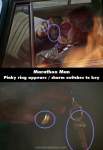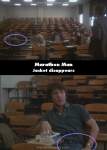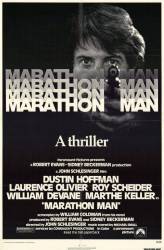Continuity mistake: Early in the movie the German guy's car stalls... In the background you can see a bus and a tan car which belongs to the Jewish guy. A few seconds later you see the Jewish guy's tan car in the mechanics shop. About 1 minute later you see the tan car and the bus in the background once again as the Jewish guy meets with the German. (00:03:50)
Continuity mistake: About 6 minutes, 45 seconds into the film, a Jewish man is pestering a German man by bumping into his tailgate. The Jewish man almost hits people crossing the street. They appear out of nowhere. In the previous shot, it was just one person standing on the curb. (00:06:45)

Continuity mistake: When the crash occurs, Klaus pulls out the key on a keychain. In the first shot, Klaus is not wearing a pinky ring on his right hand while holding the key with the round charm dangling, but in the closeup Klaus is now wearing a pinky ring on his right hand and is instead holding the keychain charm, with the key dangling. (00:08:15)

Continuity mistake: When Levy arrives at Professor Biesenthal's seminar he sits down placing his jacket on his lap. When asked about his thesis, his seating arrangement changes. The jacket appears folded on the chair to his right and the pencil he holds, disappears. (00:23:00)
Visible crew/equipment: Around 23 minutes in, a crew member's head is reflected in a vehicle as it passes. The edge of the camera lens is also visible. (00:23:23)
Continuity mistake: When Henry Levy is having his hand treated, the size of the cigarette he is smoking changes, getting larger as the shot leaves him then returns. (00:34:00)

Continuity mistake: In Uruguay, when the woman puts Christian Szell's folded shirts in the drawer, the camera pans toward the photographs on the dresser. There's an unframed photo of his brother Klaus in the closeup, but it's a different photo in the next wide shot. (00:38:25)

Continuity mistake: In the scene where the German and Jewish drivers are arguing, there is a corner establishment visible in the background with a sign that reads "wash." In certain shots, a "going out of business" sign is visible in the storefront, while in other shots, with close-ups of two passers-by observing the argument, the same corner establishment is visible without the "going out of business" sign.
Other mistake: In the beginning of the movie, the radio announcer says it is 74 degrees with a high of 89 degrees expected. The guy directing the oil truck breath is visible and is wearing a winter coat, not very likely at that temperature. People walking the streets are too heavily dressed also.
Continuity mistake: When the American guy races against the German's car, the cars in the background have no continuity between the inside and the outside shots for most of the time.
Continuity mistake: When the cars crash into the oil truck, the body in the car on the far right keeps changing: Head down against the steering wheel (as we later see it in a close-up), head missing and head up and stiff.
Revealing mistake: When Babe is hiding in the bathroom and his attackers are prising the door off the hinges, you can see the wall move as well as the door, so showing that it's a set rather than an apartment.
Character mistake: The woman who supposedly gets hit by the taxi near the end falls down well before it hits her.
Continuity mistake: When the bad guys are chasing Babe on the bridge, he jumps to the other lane below. A car crashes into the bad guys' car, and we see them get out and look down. Suddenly, it's much lighter than in the previous shots.
Continuity mistake: When the oil tanker explodes near the beginning, the fire shooting out of it comes out in different places depending on the angle. The most obvious is right after the crash. The shot changes angles, and the explosion happens a second time.
Other mistake: In the restaurant scene with Scylla (Doc), Babe and Elsa, Scylla pontificates, briefly, about wine and then orders a Chablis Grand Cru (which you don't need to be a wine buff to know is a classic white wine). However, the wine they are drinking, a few minutes later, is a red.






Answer: The diamonds were "blood money" that were stolen at the expense of many Jewish lives during the holocaust and also resulted in Babe's brother, "Doc" being murdered. For that reason, Babe would not want them, nor would he allow others to profit from them. Szell needed to risk being recognized in New York in order to retrieve the entire cache of diamonds from the bank safe deposit box after his brother, Klaus, was killed. Klaus would retrieve as many diamonds as Szell needed to sell to support himself in South America. Once Klaus was dead, no-one else could gain access to them for Szell, or if they could, probably would have stolen them.
raywest ★